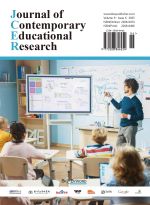Abstract
The development of new quality productivity has set new requirements for vocational education. Vocational colleges need to integrate ideological and political education into professional courses to cultivate high-quality talents with both technical capabilities and political literacy. This paper analyzes the connotation of new quality productivity and its reshaping of vocational education, explores the challenges faced by the educational mechanism of Curriculum-based Political and Ideological Education (CPIE), and proposes a “three-dimensional synergy” practical pathway. That is, to effectively promote CPIE through three dimensions: the deep integration of cases with professional content, the enhancement of teaching effects using digitization, and the optimization of the course evaluation system. It aims to provide theoretical support and practical references for the reform of ideological and political education in vocational colleges.
References
Wang ZF, Zhang GW, 2025, Mechanism and Effect of New Quality Productivity on High-Quality Full Employment. East China Economic Management, (5): 1–12. https://doi.org/10.19629/j.cnki.34-1014/f.250320005
Wang TT, 2025, The Logical Mechanism, Practical Dilemmas, and Path Optimization of Taxation Empowering the Development of New Quality Productivity. Contemporary Finance & Economics, (5): 1–15. https://doi.org/10.13676/j.cnki.cn36-1030/f.20250521.001
Xu CY, He AP, Zhou WH, 2025, Research on the Impact and Mechanism of New Quality Productivity on Green Wealth. Journal of Arid Land Resources and Environment, 39(6): 1–13. https://doi.org/10.13448/j.cnki.jalre.2025.092
Ren JQ, Jiang QY, Zhu ZY, et al., 2025, New Quality Productivity in the Marine Field: Connotations, Characteristics, Trends, and Promotion Strategies. Tianjin Social Sciences, (3): 102–109. https://doi.org/10.16240/j.cnki.1002-3976.2025.03.010
Tian QF, Yi L, 2025, Configuration Study of Technological Innovation in Strategic Emerging Industries Driving the Development of New Quality Productivity. Science Research Management, 46(5): 23–34. https://doi.org/10.19571/j.cnki.1000-2995.2025.05.003
Zhan ZH, Luo W, 2025, The Intrinsic Logic and Practical Paths of Implementing the Concept of Shared Development through New Quality Productivity. Journal of South-Central Minzu University (Humanities and Social Sciences), (5): 1–8. https://doi.org/10.19898/j.cnki.42-1704/C.20250514.02
Wang WJ, 2024, Action Logic and Promotion Path of Vocational Education Curriculum Ideology and Politics under the Background of Educational Digitalization. Education and Vocation, (24): 93–99. https://doi.org/10.13615/j.cnki.1004-3985.2024.24.006
Kang X, Tian MR, 2022, Research on the Construction of “Micro-Ideological and Political Education” in Public Foreign Language Courses in Vocational Education in the New Era. Education and Vocation, (17): 108–112. https://doi.org/10.13615/j.cnki.1004-3985.2022.17.007
Guo HC, Zhu DQ, 2021, Value Rationality and Educational Logic of Vocational Education Curriculum Ideology and Politics. Journal of Research on Education for Ethnic Minorities, 32(5): 44–54. https://doi.org/10.15946/j.cnki.1001-7178.2021.05.006
Kong XX, Tian QQ, Zhang P, et al., 2023, Exploration and Practice of Ideological and Political Education in Pharmaceutical Analysis Courses in Higher Vocational Education. Chinese Journal of Chemical Education, 44(6): 67–75. https://doi.org/10.13884/j.1003-3807hxjy.2022040296
Zhou SL, Zhang Z, 2022, Research on the Construction of Ideological and Political Education in Art Design Majors in Higher Vocational Education. Education and Vocation, (8): 89–92. https://doi.org/10.13615/j.cnki.1004-3985.2022.08.013
